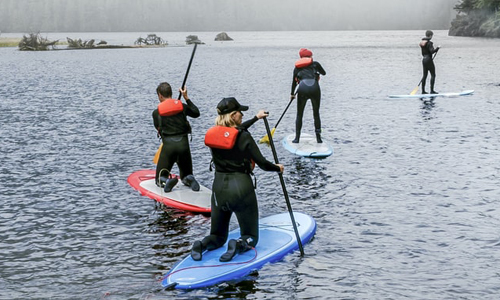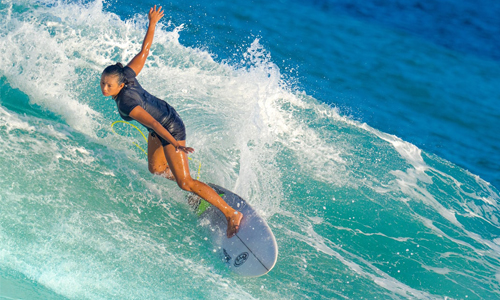Choosing the Right Wetsuit for Different Watersports
Author

Mike has a real passion for cycling, hiking and just generally being outdoors. Being from Warrington, he is only a few hours away from North Wales, The Peak District, Yorkshire and the Lake District. He has climbed Mount Kilimanjaro and done a lot of the mountains in the Lake District. His new passion is walking his dog and enjoying a pint at the end.
The UK waters are known to be cool, even during the summers. Wetsuits are therefore, a boon for all those who participate in different outdoor activities. Activities such as surfing, paddle boarding, etc., are bearable in cold waters due to the wetsuits.

Many factors affect the type of wetsuit you would buy. It may include the density, size, flexibility and the sports itself. If you are thinking of buying one, you can consider the following things:
The Time of the Year
One of the important elements to keep in mind while purchasing a wetsuit is the time of the year. You should consider checking the thickness of the wetsuit according to your understanding of cold and warm, which reflects in your body.
Many people feel cold and warm differently. Therefore, it is best to follow the recommended thickness for every season if you are not sure of what to keep.
Check the Measurements
Make sure to check the measurement before you purchase a wetsuit. If a wetsuit is baggy and loose, water might seep in, and your suit wouldn’t work properly. You should also check for the breathability quotient in your suit.
However, if your suit is tighter and restricts movement, especially in the shoulder area because of the movement of the shoulders during the activity. It is better to buy a size bigger in such cases. It should not be difficult to wear a wetsuit. However, it should not be so much struggle that you cannot get the neoprene over your shoulders and hips.
Wetsuit Thickness
It is important to check the wetsuit thickness as it is one factor that decides the amount of water that heats up inside your body. These wetsuits are measured in a ratio form which refers to millilitres, such as 3:2.
This ratio indicates that the wetsuit is three millilitres thick on the body and legs and two millilitres thick on the arm. There are different sized wetsuits by the season.
Summer Wetsuit Thickness
- 3:2 and below
Mid-season thickness
- 4:3
Winter wetsuit thickness
- 6:4
- 5:3
- 5:4
There are also short wetsuits that stop at the knee and elbows. There are also different wetsuits, which are of the ratio 4:3 but are labelled as summer suits on online websites.
How Does It Keep You Warm?
Wetsuits work by warming the water between your body and the water body. There is a thin layer of water that exists between your skin and the neoprene of the suit. Because of the warmth of your body, it becomes easier to warm up the water and thus; you can remain inside the water for a longer period.
Types of Wetsuits for Sports Surfing
There are different types of wetsuits used for sports surfing depending upon the time of the year as mentioned above. Choose thinner summer wetsuits if you have a low tolerance to heat and vice versa for the winter months.
You can go for an all-rounder, which is the 4:3 suit that can be carried from April to October.

There are swim specific wetsuits that are used for kayaking, paddle-boarding, etc. You can compete with these wetsuits in triathlons. Designed as lightweight wear so you can pursue professional swimming.
Kayaking Wetsuit
These are used for kayaking. If you are getting wet and cold, you can consider these wetsuits in general as well. Start with something flexible, and you are ready! During the summer months, a short wetsuit may be a great choice as you can enjoy the heat in the UK.
Paddle-boarding Wetsuit
A perfect wetsuit for paddle-boarding, these wetsuits are useful as a full-length summer suit as you are more likely to submerge in cold water. A short wetsuit can be sufficient to keep you warm during the British summer months.
Considering Buying a Wetsuit This Summer?
Choose your wetsuit well and enjoy your watersport activity with your friends, family loved ones, or solo.
Author

Mike has a real passion for cycling, hiking and just generally being outdoors. Being from Warrington, he is only a few hours away from North Wales, The Peak District, Yorkshire and the Lake District. He has climbed Mount Kilimanjaro and done a lot of the mountains in the Lake District. His new passion is walking his dog and enjoying a pint at the end.
Categories
- Sport (28)
- Product Reviews (3)
- Team Outdoor Look (7)
- Mike Wild (2)
- Mike Payton (2)
- Suse Hammond-Pears (3)
- Snowboarding (12)
- Latest Offers (105)
- Shop Talk (1)
- Competitions (7)
- Walking (413)
- Lifestyle Fashion (8)
- Travel (86)
- Kit Guides (176)
- Workwear Clothing (6)
- Safety Workwear (4)
- Health/Fitness (289)
- Skiing (91)
- Great Outdoors (1316)
- Cycling (92)
- January 2025
- December 2024
- November 2024
- October 2024
- September 2024
- August 2024
- July 2024
- June 2024
- May 2024
- April 2024
- March 2024
- February 2024
- January 2024
- December 2023
- November 2023
- October 2023
- September 2023
- August 2023
- July 2023
- June 2023
- May 2023
- April 2023
- March 2023
- February 2023
- January 2023
- December 2022
- November 2022
- October 2022
- September 2022
- August 2022
- July 2022
- June 2022
- May 2022
- April 2022
- March 2022
- February 2022
- January 2022
- December 2021
- November 2021
- October 2021
- September 2021
- August 2021
- July 2021
- June 2021
- May 2021
- April 2021
- March 2021
- February 2021
- January 2021
- December 2020
- November 2020
- October 2020
- September 2020
- August 2020
- July 2020
- June 2020
- May 2020
- April 2020
- March 2020
- February 2020
- January 2020
- December 2019
- November 2019
- October 2019
- September 2019
- August 2019
- July 2019
- June 2019
- May 2019
- April 2019
- March 2019
- February 2019
- January 2019
- December 2018
- November 2018
- October 2018
- September 2018
- August 2018
- July 2018
- June 2018
- May 2018
- April 2018
- March 2018
- February 2018
- January 2018
- December 2017
- November 2017
- October 2017
- September 2017
- August 2017
- July 2017
- June 2017
- May 2017
- April 2017
- March 2017
- February 2017
- January 2017
- December 2016
- November 2016
- October 2016
- September 2016
- August 2016
- July 2016
- June 2016
- May 2016
- April 2016
- March 2016
- February 2016
- January 2016
- December 2015
- November 2015
- October 2015
- September 2015
- August 2015
- July 2015
- June 2015
- May 2015
- April 2015
- March 2015
- February 2015
- January 2015
- December 2014
- November 2014
- October 2014
- September 2014
- August 2014
- July 2014
- June 2014
- May 2014
- April 2014
- March 2014
- February 2014
- January 2014
- December 2013
- November 2013
- October 2013
- September 2013
- August 2013
- July 2013
- June 2013
- May 2013
- April 2013
- March 2013
- February 2013
- January 2013
- December 2012
- November 2012
- October 2012
- September 2012
- August 2012
- July 2012
- June 2012
- May 2012
- April 2012
- March 2012
- February 2012
- January 2012
- December 2011
- November 2011
- October 2011
- September 2011
- August 2011
- May 2010
- April 2010
- March 2010
- February 2010
- January 2010
- November 2009
- October 2009
- September 2009


Submit a Comment